
Review Article
Austin Neurosurg Open Access. 2015;2(2): 1030.
Meningiomas Surgery in Italy in the Nineteenth Century: Historical Review
Sebastiano Paterniti*
Department of Neurosciences, University of Messina, Italy
*Corresponding author: Sebastiano Paterniti, Department of Neurosciences, University of Messina, Italy, Viale Consolare Valeria, Gazzi, 98100 Messina, Italy
Received: May 11, 2015; Accepted: June 26, 2015; Published: June 29, 2015
Abstract
The meningiomas occupy a very important role in the history of neurosurgery. This work refers the remarkable contributions of Italian authors in the early ages in the surgery of these tumors.
Through an extensive literature review it was possible to find at least twentytwo cases operated on in Italy in the nineteenth century.
The author emphasizes the pioneering aspects of the operations performed by Andrea Vacca’Berlinghieri (Pisa, 1813), Zanobi Pecchioli (Siena, 1835), Francesco Durante (Rome, 1884), and Guido Bendandi (Bologna, 1895). These cases are widely mentioned in the international literature on meningiomas, but other cases reported here were not cited in published reviews.
It should be stressed that the results recorded in the cases examined in this study were generally positive, with a mortality rate of 28.6% and a good outcome in 71.4%.
Although the literature has been extensively reviewed for this work, the research cannot be considered complete; likely at that time other cases of meningiomas were surgically treated in our country and it is realistic to believe that not all have been published.
Keywords: Meningiomas surgery; Italy; Nineteenth century
Introduction
In Italy the surgery of cranio-cerebral tumors began in the nineteenth century, thanks to the courage and the value of some great general surgeons.
At the beginning only tumors with extracranial expansion or those causing changes in the overlying skull could be diagnosed and occasionally removed; in the last decades of the century, the progressive knowledge on the localization of brain functions, made possible the diagnosis of tumors even in the absence of external manifestations, based on neurological signs and symptoms; the introduction of anesthesia, asepsis and antisepsis allowed sometimes to remove also neoplasms with intracranial location alone.
Undoubtedly, the meningiomas occupy an important place in the history of brain tumors and, therefore, in the history of neurosurgery; before all, the meningioma, a term coined by Harvey Cushing in 1922 and variously called first (fungoid tumor of the dura mater, sarcoma, endothelioma, fibroma, fibrosarcoma, psammoma) is the brain tumor known for the longest time, since ancient times, as it could result in changes of the skull. For this reason the meningioma also represents the first brain tumor for which the operative practice was possible.
The first attempts to surgically treat the meningiomas date back to the mid-eighteenth century; however, their surgical removal substantially began in the 19th century.
It should be recognized to Italians a remarkable historical role in the meningiomas surgery. In this paper the main contributions of Italian authors are reported; some are considered important enough to be mentioned not only in works that have analyzed specifically the role of our compatriots in the historical evolution of neurosurgery [1-7] but also in many publications of the international literature on intracranial meningiomas, particularly on their historical aspects [8- 12].
Review
For the present study many text-books and works on the history of the neurosurgery, in particular on the part of the surgery of meningiomas have been consulted; furthermore, a search was made using Pubmed and Pubmed central.
Through this review methodology I found at least twenty-two cases of meningiomas surgically treated in Italy in the nineteenth century. Table 1 shows a summary of the most important data of these cases [13-38].
Surgeon
Year of Surgery
City
Tumor
Result
Andrea VaccàBellinghieri [13]
1813
Pisa
Sarcoma of the dura mater at synciput
?
FilippoPalazzi [14]
1827
Bologna
Sincyputendotelioma
Death
ZanobiPecchioli [15]
1835
Siena
Synciput ulcerated fungus of the dura mater
Recovery
Giovanni Valeriani [16]
1875
Bologna
Large frontal sarcoma eroding the bone
Recovery
GiacomoFilippoNovaro [17]
1879
Turin
Skull periostal sarcoma with intracranial expansion
Recovery
GiacomoFilippoNovaro [18]
1883
Turin
Frontal hyperostosing tumor
Death
Francesco Durante [20]
1883
Rome
Fibroma of the cranial base extending into the nasal fossa
Recovery
Francesco Durante [20-24]
1884
Rome
Olfactory groove fibrosarcoma
Recovery
Francesco Durante [25]
1898
Rome
Rolandicfibrosarcoma
Recovery
AzzioCaselli [26]
1886
Genoa
Myelogenic sarcoma of the bregma with dural involvement
Improvement
Felice Celli [27]
1891
Cremona
Rolandicendotelioma
Death
Paolo Postempski [28]
1891
Rome
Rolandicendotelioma
Recovery
Paolo Postempski [29]
1892
Rome
Frontal sarcoma
Recovery
RaffaeleBastianelli [30]
1895
Rome
Anterior cerebral fossa sarcoma
Recovery
EmidioTassi [31]
1895
Rome
Sarcoma of parietal dura mater
Recovery
EmidioTassi [31]
1895
Rome
Tuberculum of temporal dura mater
Recovery
Guido Bendandi [32-34]
1895
Bologna
Cerebellopontine angle fibroma
Improvement
Guido Bendandi [32]
1898
Bologna
Falxendotelioma
Death
Eugenio Casati [35]
1896
Fermo
Fronto-parietal sarcoma
Death
Alberto Codivilla [36]
1896
Imola
Frionto-basal sarcoma
Recovery
Vittorio Marchi [37]
1897
Jesi
Cerebellar endotelioma
Death
OrazioD’Allocco [38]
1899
Fermo
Rolandic sarcoma
Improvement
Table 1: Summary of cases.
It is necessary to specify that the table shows the pathologic definition used by the authors in each case, since at that time was not yet proposed the term meningioma; the tumor was considered likely to be meningioma based on the surgical report of each case indicating the dural attachment of the tumor and in accordance to the “history of the nomenclature of meningioma” listed by Al-Rodhan and Laws [8]. The most significant cases listed in the table are here described with more details.
The first author to mention is ANDREA VACCA’ BERLINGHIERI (Figure 1), born in Montefoscoli (Pisa) on February 3, 1772 and died in Orzignano (Pisa) on September 6, 1826, Professor of Surgery at University of Pisa. Among his many works here is of interest the manuscript Trattato di Chirurgia Pratica, 1813 [13], never published, probably dictated to one of his students; its discovery was made accidentally by David Giordano, who referred in detail in an article on surgeon of Pisa [39].
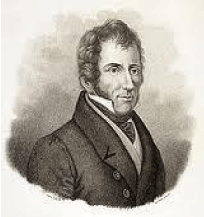
Figure 1: Andrea VaccàBerlinghieri.
The manuscript consists of 488 pages, with distribution of the chapters “from head to feet”. The Treatise begins precisely with the head surgery where Vaccà Berlinhieri first dwells upon the practice of trephination and then, in the words of Giordano, “rises to greater boldness in the treatment of sarcomas of the dura mater.” Indeed, a patient with meningioma underwent surgical excision in Pisa is described.
Until then, the treatment of these tumors was limited to cautery, or, at most, to the epidural excisions or ligatures, procedures clearly insufficient; Vaccà Berlinhieri proposed and performed a most radical operation, albeit very bold. After a craniectomy with five or six burr holes on the outskirts of the fungus, the tumor was removed together the dura mater from which it originated, tying the cut vessels.
As observed by Vittorio Sironi [40], it was the Author’s credit that he described in detail the technique to dominate the copious bleeding during tumor removal; if the meningeal artery is damaged, VaccàBerlinghieri advised to occlude it by bending onto the edge of the bone a lead sheet coated with rosin or agaric or keeping a small feather over the mouth of the vessel. The precise location of the tumor and the surgical outcome is not known.
Andrea VaccàBerlinghieri was the first to consider a previous head injury as a possible cause of a meningioma; this pathogenic hypothesis was suspected later also by other, including Harvey Cushing [41] and the question is still debated and not resolved [42].
To another Italian, ZANOBI PECCHIOLI, it must be assigned an even more significant role, since he was the first to remove successfully a meningioma. Born in San Miniato (Pisa) in August 1801 and died in Florence in January 1866, Pecchioli was Professor of Clinical Surgery and Operative Medicine at Modena and then at Siena University.
In 1847 he published an account of surgeries performed during 16 years, from 1832 to 1847; 16 of the 1524 reported operations involved trephining of the skull. One of these interventions was carried out in Siena on July 29 1835 for the resection of a meningioma, defined fungus of the duramater. The case was not referred in the literature by Pecchioli but was described by theEditorial Board of the “NuovoGiornaledeiLetterati- Scienze”, in 1838 [15] (Figures 2 and 3).
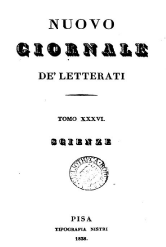
Figure 2: Cover page of the Journal “Nuovo Giornale dei Letterati” (Pisa,
1838).
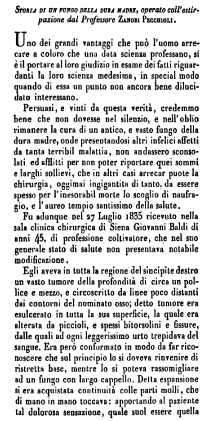
Figure 3: First page of the paper reporting the Pecchioli’s case.
The clinical history of a 45 year old man is reported: the patient “had in the whole region of the right sincyput a large tumor, about an inch and a half deep, surrounded by lines not far from the margins of the above-mentioned bone. The entire tumor surface was ulcerated … it was so shaped as to suggest that originally it must have had a narrow base and looked like a mushroom with a broad cap”. The patient suffered “from long term severe headache”, exacerbated by digital compression of the mass for which Pecchioli advanced the diagnosis of “a cancerous fungus of the dura mater.”
The different steps of the operation can be summarized as follows: with a convex small knife the surgeon made an incision in the healthy soft tissue surrounding the tumor, dissected them and detached them together with the tumor. He removed from the bony surface of the parietal bone the entire exophytic portion of the tumor (“that portion of the fungus lying outside of the cavity”) and, therefore, removed the pericranium and the eroded bone. Since the resulting bone defect was not large enough to reveal the limits of the lesion Pecchioli drilled three separated holes and then joined them to obtain an large triangular craniotomy, thus exposing the mass which was removed together with the dural insertion, leaving the underlying arachnoid exposed in large zones. Over the extensive opening was placed an artificial integument of fine linen soaked in sweet almond oil.
The operation, that “was impressive, painful and long-term”, was followed by full recovery; the patient survived and was followed for more than 2 years; he was in good health and showed no evidence of recurrence.
The article concludes with a note of the Editorial Board of the Journal:” the operation carried out in the Amphitheatre of Siena seems to be the first that has actually been operated on. This is a panegyric to the glory of Italian surgery and clearly demonstrate that the Italians are not inferior to the peoples other side of the Alps.”
As said, historically this is the first reported successful removal of a meningioma [4,8,9,11,40,43]. In 1840, this intervention was chosen for the competition to the Chair of Clinical Surgery at University of Paris.
Of note are also two cases operated on in Turin, in 1879 and 1883, by GIACOMO FILIPPO NOVARO; he was born in Diano Marina (Imperia) on May 1, 1843 where died on September 5,1934; he devoted himself to academic career, first at the University of Turin, later was Professor of Clinical Surgery at Siena, Bologna and finally Genoa Universities.
Once again the diagnosis of the tumor was based on the irregularities of the skull; the first patient recovered after the excision of a skull periostal sarcoma with intracranial expansion; the second patient, suffering from seizures due to a parasagittal frontal hyperostosing meningioma, died one hour after the operation because of acute anemia due to a profuse intraoperative bleeding, from the diploe and especially from the superior sagittal sinus, despite the surgeon before dissecting the mass had proceeded to apply two hemostatic forceps on the longitudinal sinus, one forward and the other back of the tumor.
In this time appeared the essential contribution by Sicilian surgeon FRANCESCO DURANTE (Figure 4). He was born in Letojanni (Messina) on June 29, 1844 where died on October 2, 1934; Durante was Director of the Surgical Clinic of Rome University and an outstanding leader of the Italian surgery for a very long time; certainly he was a pioneer of Italian Neurosurgery [1-7]; to Durante is recognized an historical role in the development of Neurosurgery and, in particular, in the surgery of meningiomas.
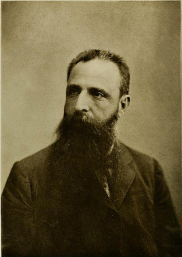
Figure 4: Francesco Durante.
Durante was the first to successfully remove a brain tumor (olfactory groove meningioma) diagnosed only on clinical evidence.
However, it should stressed that he, before the operation that made him universally known, successfully carried out a special operation for a tumor, having respected a meningioma (defined by the author “fibroma”) of the skull base extending into the nasal cavity, using an original transpalatin approach; the case was referred to Medical Academy of Rome [19].
Francesco Durante’s fame is linked to the intervention performed in Rome on June 1, 1884 on a 35 years old woman whose symptoms (anosmia, psychic disorders, protrusion of the eyeball) allowed the exact diagnosis of intracranial tumor sited in frontal region that was surgically removed.
The case, and the patient, was presented, at the Meeting of the Italian Society of Surgery and a few months later at the Royal Academy of Medicine of Rome [20].
The operation was presented, a few years later, in September 1887 at the Surgical Section of the International Medical Congress of Washington [21] and in the same year was published in the Lancet [22] (Figure 5).

Figure 5: Durante’s article on the Lancet.
Some passages of the text of this historic publication are transcribed here: “In May, 1884, C.B,, a woman, thirty-five years of age and a native of Narni, came under my care…The course of disease, the loss of memory and of the sense of smell, and the objective and subjective state of the patient led me to believe in the presence of a tumour within the cranium, the pressure of which affected the anterior lobe of the brain and paralyzed or destroyed the olfactory nerve. Moreover, the displacement of the globe of the eye led me to believe also that the tumor had penetrated the superior arch of the orbital cavity. Such being my diagnosis, I now proposed to the patient an operation that would remove the offending object, explaining to her the gravity of the operation without reserve. She was brave, and she consented.
To reach the tumour it was necessary to make a large opening in the left frontal bone … The dura mater being now exposed… With great care I now began to scoop out the tumour. The tumour was lobular, of the size of an apple, and weighed seventy grammes. It occupied the anterior fossa at the base of left cranium, extending to right and upon the cribriform lamina, which it destroyed. Posteriorly it extended to the glenoid tubercles before the sellaturcica … On the fifteenth day the patient returned to her home, doing very well.
Three months after I presented my patient to the Chirurgical Society at its meeting in Perugia in 1884. She was in a happy frame of mind, and willingly related her experience. She stated that now all of her faculties and moral condition were normal, and that she had even regained her sense of smell. This greatly surprises me, for I felt sure that I had destroyed the left olfactory in removing the tumour, which had destroyed the cribriform lamina of ethmoid. Upon experimenting, however, with aromatic substances, we found that she could only smell with the right, and that the left was totally insensible, its olfactory having been destroyed either by the pressure of the tumour or by the operation itself. The part of the bone which had been removed was now partially reproduced, the cavity in the region of the operation had disappeared, and the eye had regained almost entirely its normal position. The tumour, under the microscope, presented a multiform fibro-cellular structure of sarcoma.
It is now four years since that operation was performed, and my patient is in perfect health. My diagnosis and the operation, apparently so hazardous at the time, are therefore justified by the result. And, though such operations have generally failed, the success of mine should secure proper consideration at the hand of modern surgery.
The progress of experimental pathology and of studies of cerebral localization every day now smoothes our way to the diagnosis of cerebral diseases, so that the cranial cavity may in future justly enter into the dominion of surgery. The frontal and parietal regions can now be successfully attacked by the scalpel of the surgeon, and many affections of the meninges become trophies of rational surgery”.
The patient, after many years, in March 1896, underwent new surgery for tumor recurrence, which was in detail reported by Durante in a publication of the Proceedings of the Italian Society of Surgery of 1896 [23] and in his Treatise of Surgical Pathology [24]. The postoperative course was excellent: the patient was discharged in complete physical, moral and intellectual health and survived at least ten years after the second operation.
Durante surgically treated at least another case of meningioma: a large left fronto-parietal dura mater sarcoma, once again successfully [25].
As can be seen in Table 1, other cases of meningiomas were treated by surgery in Italy during the period considered in this review.
Some treaties of brain surgery [44-46] at that time, and recently Al-Rodhan et al. [8], cite a case of PAOLO POSTEMPSKI (Rome, 1851-1926), chief surgeon of Consolation Hospital in Rome and Professor of Pathology and Surgical Clinic of the University; he operated in Rome on 22 February 1891, a 54 years old woman who had developed gradually right brachial monoplegia and, after many years, frequent attacks of Jacksonian epilepsy, impaired speech, and mental disorders. The neurologist EzioSciamanna (Figure 6) formulated the diagnosis of a cortical tumor sited below the half of the ascending frontal, in proximity of the Rolandic region; Postempski excised the tumor, histologically classified as endothelioma. At discharge, after a few months from the operation, the patient, free from seizures, showed only a slight difficulty in movement of the hand [28] (Figure 7). In the following year Postempski successfully removed a frontal sarcoma [29].
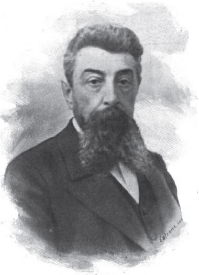
Figure 6: Ezio Sciamanna.
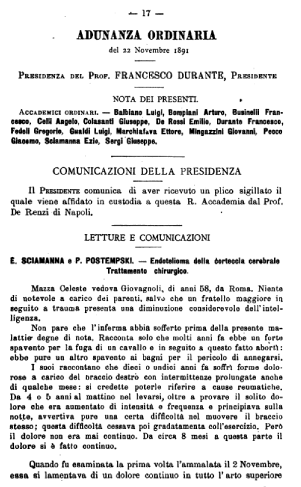
Figure 7: First page of Sciamanna and Postempski work.
A special mention should be given to the posterior cranial fossa meningioma operated upon in Bologna on 19 February 19, 1895 by GUIDO BENDANDI, from Forlimpopoli, Primary Surgeon at Maggiore Hospital in Bologna. A 17 years old boy suffered for many months of headache, vomiting, dizziness, staggering gait, scanning speech, hearing loss and presented on clinical examination facial paralysis, ptosis, nystagmus; Augusto Murri, Professor of Medicine having special interest in neurology and in brain space-occupyng lesions, diagnosed a cerebellar tumor and referred the patient for surgery. Bendandi removed a cerebellopontine angle fibro-sarcoma; the intervention led to a significant improvement of the patient. The case was published by Murri [33,34] (Figure 8), who related the clinical picture and by Bendandi who described the surgicalreport [32]. This case assumes an historical character, being among the first posterior fossa tumors operated with a good outcome, enough to be quoted by Harvey Cushing [47].
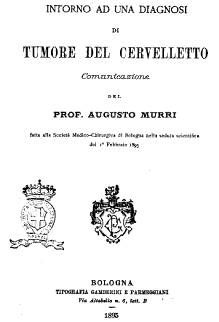
Figure 8: Cover page of Murri’s publication.
I want to emphasize that in the cases treated during the last decades of XIX century the diagnosis was made not for the external manifestation of the tumor but on clinical picture; it is right to stress that essential to the surgeon in planning the operation was the contribution of the neurologist.
Discussion
To the meningiomas should be assigned a key role in the history of neurosurgery. Collin Mac Carty wrote: “if we were to designate an intracranial neoplasm that has had the most effect on the development of neurological surgery, very likely the intracranial meningioma would be prominently considered” [47,48]. Afterwards, the same concept was expressed also in other works devoted to the history of the meningiomas; for example according to Wang et Al “the evaluation of the diagnosis and treatment of meningiomas represent a microcosm of the evolution of neurosurgery. In many ways a meningioma is the soul of neurosurgery” [12] and so Okonkwo and Laws: “Meningiomas have been front and center in the evolution of discipline of neurosurgery. The current understanding and treatment of meningiomas represent the culmination of centuries of dedication by anatomists, pathologists, neurosurgeons and others to this everintriguing group of tumor. Patients will continue to benefit as contemporary neurosurgeons pursue their craft from the shoulders of giants before them” [11].
The Italians played a leading role in meningiomas surgery. Their contribution was very important, under certain aspects pioneering, both in the first stage, when could be operated only the tumors having an extracranial expansion or determining deformations of the skull, both in the next steps, starting from the last decades of the nineteenth century, when the introduction of anesthesia, asepsis and antisepsis and knowledge of cerebral localizations made possible the diagnosis and sometimes even the removal of tumors located exclusively in intracranial site.
I focused on some cases that in the international literature are considered “surgical milestones” in the history of meningiomas.
The contributions by Andrea VaccàBerlinghieri and Zanobi Pecchioli as pioneers in the surgery of meningiomas are recognized worldwide.
The historical importance of the operation performed by Francesco Durante was unanimously acknowledged [1-12,49,50]; his great historical achievement was also admitted by Harvey Cushing who in his famous monograph on meningiomas [41] writes on page 270: “chronologically the first successful operation for intracranial tumor was performed by Francesco Durante, professor of clinical surgery in the University of Rome”.
About the Augusto Murri and Guido Bendandi case Cushing in his monograph on cerebellopontine angle tumors wrote, page 245, “Augusto Murri’s clinical report is a most noteworthy one for the time” [47].
Some works on the history of meningiomas also cited the cases operated by Vittorio Marchi, Paolo Postempski, Azzio Caselli, GianFilippoNovaro while in the literature are not mentioned other cases included in this review.
For an accurate assessment of the cases surgically treated in Italy, a wide research on the international literature was made; in the same period have been published works on 50 cases operated on outside of Italy, in which the operative results is clearly reported: deaths were recorded in 18 cases, i.e. in 36%, and positive results in 64% (32 cases). Among the twenty-two “italian” cases the mortality rate was 28.6 % and a positive result was obtained in 71.4% (the postoperative outcome in VaccàBerlinghieri’s case is unknown).
Conclusion
For this work an extensive literature review was carried out; however, the research cannot be regarded as complete. It is likely that the reported cases were not the only ones operated in Italy in the nineteenth century, perhaps because not all have been published.
Al-Rodhan and Laws [8] judged “surgical milestones in the history of meningiomas” the operations performed by Berlinghieri, Pecchioli, Durante, Marchi.
Above all Zanobi Pecchioli and Francesco Durante were early pioneers in meningiomas surgery [8,9,43,49,50-55].
Pecchioli for the first time successfully removed a meningioma (“fungus of the dura mater”); the lesion was a large ulcerated cranial outgrowth at the level of right sincyput originating from the dura and eroding the bone; Durante was the first to successfully remove a brain tumor (olfactory groove meningioma) which had been diagnosed on clinical ground, thus providing contribution to the history of cerebral localization, especially of the function of frontal lobes.
References
- Broggi G. Neurosurgery in Italy: origins to modernity. Neurosurgery. 2004; 55: 718-721.
- Conforti P. Discorso celebrativo del XXV anniversario di fondazione della società italiana di Neurochirurgia. J Neurosurg Sciences. 1975; 19: 1-5.
- De Caro GM, Brunori A, Giuffrè R. [Neurosurgery in Rome: 1880-1970]. Ann Ital Chir. 1998; 69: 249-284.
- Guidetti B, Giuffrè R, Valente V. Italian contribution to the origin of neurosurgery. Surg Neurol. 1983; 20: 335-346.
- Mastronardi L, Ferrante L. Neurosurgery in Italy: the past, the present, the future. Neurosurg Rev. 2009; 32: 381-386.
- Sironi VA. Contributo alla storia della neurochirurgia in Italia: considerazioni sui primi tentativi di asportazione di tumori cerebrali alla fine dell’800 ed agli inizi del ‘900. Medicina e Storia (a cura di O. Galeazzi), Il Lavoro editorial. Ancona. 1986; 151-157.
- Tanfani G. Per la storia della Neurochirurgia (Qualche commento ed una prolusione). Riv Storia Sci Med Nat. 1940; 5-6: 88-90.
- al-Rodhan NR, Laws ER Jr. Meningioma: a historical study of the tumor and its surgical management. Neurosurgery. 1990; 26: 832-846.
- Bakay L. The history of surgery of meningiomas. Schmidek HH, editor. In: Meningiomas and their surgical management. Philadelphia: Saunders WB. 1991; 173-180.
- Gonzales MG, Bouzas ML. Historia de los meningiomas. Bouzas ML, Gonzales MG, editors. In: Meningiomas. Universidade de Santiago de Compostela. 2002; 11-19.
- Okonkwo DO, Laws ER. Meningiomas: historical perspective. Lee JH, editor. In: Meningiomas. Diagnosis, treatment and outcome. London: Springer-Verlag. 2009; 3-10.
- Wang H, Lanzino G, Laws ER. Meningiomas, the soul of neurosurgery. Historical review. Seminars in Neurosurgery. 2003; 14: 163-168.
- Vacca’ Berlinghieri A. Trattato di Chirurgia Teorico Pratica, 1813 (unpublished manuscript quoted by Giordano D).
- Bizzozero G, Bozzolo C. Studi sui tumori primitivi della dura madre. Rivista Clinica di Bologna. 1874; 4: 233-266.
- Pecchioli Z. Storia di un fungo della dura madre operato coll’estirpazione dal Professor ZanobiPecchioliNuovo Giornale dei Letterati. 1838; 36: 39-44.
- Valeriani G. Vasto Carcinoma del cranio asportato con ansa galvanica. Gazzetta delle Cliniche. 1875; 427.
- Novaro GF. Sarcoma periostale del cranio. Estirpazione. Guarigione. Giorn Acad Med Torino. 1879; 331.
- Novaro GF. Sulla Chirurgia cerebrale. Prelezione al corso di clinica chirurgica, letta il 12 Gennaio 1891 nell’Ospedale S. Orsola. Bull Soc Med Bologna. 1891; II: 63-88.
- Durante F. Estirpazione di un fibroma della base del cranio con un nuovo processo operatorio. Bull R AccadMed Roma. 1884; 1: 12-25.
- Durante F. Estirpazione di un tumore endocranico. Bull R Accad Med Roma. 1884; 7: 247-252.
- Durante F. Contribution to endocranial surgery - Transactions of the Ninth International Medical Congress. Washington, DC, September. 1887; 1: 570.
- Durante F. Contribution to endocranial surgery. Lancet 1887; 2: 654-655.
- Durante F. Intorno a due tumori endocranici della regione frontale – ArchAtti. SocItalChir. 1897; 12: 3-28.
- Durante F. Trattato di Patologia e Terapia Chirurgica. Roma: Edizioni Dante Alighieri. 1899; 3: 227-233.
- Durante F. Casi di Chirurgia Cerebrale. Com XV Meeting della Società Italiana di Chirurgia. Roma. 1900; 27-30.
- Caselli A. Sarcoma mielogeno del bregma con impianto sulla dura madre. RifMed. 1886; 2: 199-202.
- Celli F. Sopra un caso di epilessia jacksoniana da tumore della regione rolandica destra curato colla trapanazione del cranio ed esportazione. Cremoma. Tip. Della Regione già Renzi e Signori. 1891.
- Sciamanna E, Postempski P. Endotelioma della corteccia cerebrale, Trattamento chirurgico. Bull R AccadMed Roma. 1892; 18: 17-34.
- Postempski P. Tumore cerebrale. Estirpazione. Guarigione. Bull R AccadMed Roma. 1893; 27.
- Bastianelli R. Sarcoma della fossa cerebrale anteriore. Bull SocLancOsp Roma. 1895; 15: 20-21.
- Tassi E. Qualche osservazione sulla craniotomia. Bull R Accad Med Roma. 1895; 21: 537-551.
- Bendandi G. Contributo alla chirurgia del sistema nervoso centrale e del ganglio di Gasser. Bologna, Gamberini e Parmeggiani. 1900.
- Murri A. Intorno ad una diagnosi di tumore del cervelletto. Bologna, Gamberini e Parmeggiani. 1895.
- Murri A. Upondiagnosis of tumour of the cerebellum. Lancet 1897; 149: 291-295.
- Obici G, Tambroni R. Due casi di tumore dei lobi frontali. Riv Pat NervMen 1897; II: 155-164; 255-262.
- Codivilla A. 31 casi di chirurgia cranica e cerebrale. Imola, Tip. Galeati. 1897.
- Rizzoli AA. An unusual case of meningioma with the involvement of Russell's hook bundle as described by Vittorio Marchi (1851-1908). Med Hist. 1973; 17: 95-97.
- Rizzoli AA. An unusual case of meningioma with the involvement of Russell's hook bundle as described by Vittorio Marchi (1851-1908). Med Hist. 1973; 17: 95-97.
- Giordano D. La chirurgia di Andrea VaccàBerlinghieri. Riv Storia Sci MedNat. 1927: XVIII (3-4): 75-106.
- Sironi VA. Il ruolo dei chirurghi toscani dell’ottocento nella nascita della chirurgia cerebrale. Comunicazione al XXXIX Congresso di Storia della Medicina. Firenze. 1998; 12-14.
- Cushing H, Eisenhardt L. Meningiomas: their classification, regional behavior, life history and surgical end results. Baltimore, Thomas Publisher, Springfield, IL. 1938.
- Paterniti S. Traumi cranici e Tumori cerebrali. Vexata quaestio. Roma: AracneEditrice. 2013.
- Giuffrè R. Successful radical removal of an intracranial meningioma in 1835 by Professor Pecchioli of Siena. J Neurosurg. 1984; 60: 47-51.
- Chipault A. Chirurgie operatoiredusystemenerveux Tomo I. Paris: Rueff ed. 1894; 364-368.
- D’Antona A. La nuova chirurgia del sistema nervoso centrale (cervello, cervelletto, midollo spinale). Napol: Tip. Trani. 1893.
- Oppheneim H. Tumors of the brain. In: Text-book of Nervous diseases. II ed. Philadelphia: Lippincott Co. 1900.
- Cushing H. Tumours of the nervusacusticus and the syndrome of the cerebellopontine angle. Philadelphia – London: Saunders. 1917.
- MacCarty CS, Taylor WF. Intracranial meningiomas: experiences at the Mayo Clinic. Neurol Med Chir (Tokyo). 1979; 19: 569-574.
- Guidetti B. Francesco Durante. June 29, 1844 to October 2, 1934. Surg Neurol. 1983; 20: 1-3.
- Tomasello F, Germanò A. Francesco Durante. The history of intracranial meningiomas and beyond. Neurosurgery. 2006; 59: 389-396.
- Priola SM, Raffa G, Abbritti RV, Merlo L, Angileri FF, La Torre D, et al. The pioneering contribution of italian surgeons to skull base surgery. World Neurosurg. 2014; 82: 523-528.
- Schiller F. Early approaches to brain tumors. Neurosurgery. 1996; 38: 1023-1030.
- Desai R, Bruce J. Meningiomas of the cranial base. J Neurooncol. 1994; 20: 255-279.
- Maroon JC. Skull base surgery: past, present, and future trends. Neurosurg Focus. 2005; 19: E1.
- Liu CY, Apuzzo ML. The genesis of neurosurgery and the evolution of the neurosurgical operative environment: part I-prehistory to 2003. Neurosurgery. 2003; 52: 3-19.